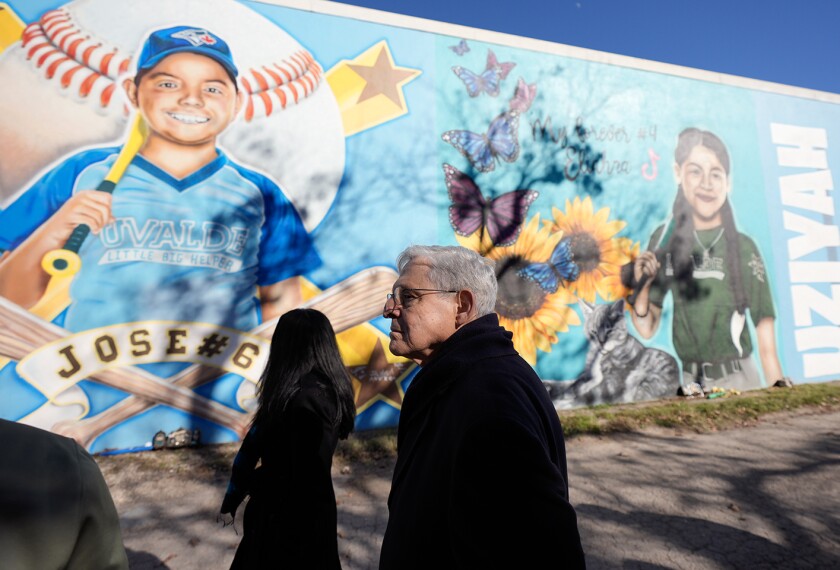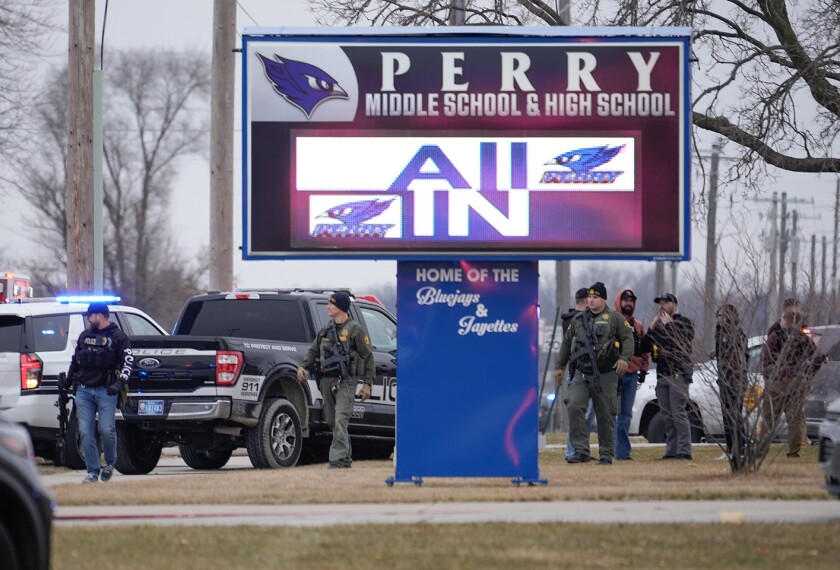For the general public, conversations about school safety are typically sparked by frightening events, like shootings. But for district administrators, school safety is a year-round conversation that is complex, emotional, and oftentimes logistically complicated.
Districts’ approaches to safety span everything from bullying prevention to active shooter drills. They must evolve to face the demands of new research, public opinion, community factors, state mandates, and financial constraints.
Many districts will face a new round of safety decisions in the new year as state lawmakers open legislative sessions to consider new bills, school boards respond to challenging budget projections, and political candidates debate issues like policing and student mental health as part of 2024 campaigns.
Here are five key school safety conversations that emerged in 2023, and will surface again for school districts next year.
1. How to prepare for hoax “swatting” calls
False reports of school shootings, known as “swatting” calls, have emerged as one of the most perplexing issues for law enforcement and educators alike.
In a swatting incident, police respond to a call of a shooting in progress at a school. Callers often claim to be inside the building as the attack is taking place, sometimes citing specific room numbers to add to the credibility of their reports, according to local news reports. Such calls often target several districts in the same region on the same day.
Though the reports are false, the law enforcement response—and the resulting fear—are real. Swatting calls have sparked lockdowns, parental panic, and confusion in hundreds of schools. The Educators School Safety Network, a school safety consulting organization, tracked media coverage of 446 false reports of school violence during the 2022-23 school year. But the actual number of swatting attempts may be higher because the events aren’t always covered individually, the organization said.

The FBI is investigating swatting calls, and law enforcement agencies at the state and local levels have identified similarities, including a call with a “foreign accent” and phone numbers that can be traced back to an online calling service based in Canada, the Washington Post reported. There is no federal law against swatting, but many states have laws against false 911 reports, some with heightened penalties if the police response results in injury.
Districts have prepared for swatting calls by warning parents about the trend in advance and setting clear policies about how to communicate in the event of a lockdown, administrators told Education Week. When swatting calls do occur, principals have worked to debrief with students, talk through their experiences, and acknowledge their fears.
“There are some kind of sick people out there,” Andrew Lavier, the principal of Alamosa high school in Alamosa, Colo., said after his school was targeted by a swatting call in 2022. “I don’t know who would do that to a school.”
Key questions for districts: Does your school system have procedures to communicate as clearly as possible during crisis events? Do you have resources to respond to the emotional effects of lockdowns?
2. The role of AI in school safety
A growing number of districts have purchased AI weapons-detections systems to help keep weapons out of buildings. The systems, similar to those that screen fans at large sports venues, use a combination of AI software, cameras, and electromagnetic sensors to detect possible weapons as students enter buildings.
However some administrators who’ve purchased the technology have backtracked, returning to older techniques like metal detectors and random bag checks to search for weapons.
The Utica City School District in New York made such a switch after its AI system failed to detect knives and a gun, administrators told Education Week in April. The Urbana, Ill., school system, reported consistent false alarms with common items like water bottles, slowing down screenings.
Officials in one district created a video to show students how to hold frequently misidentified objects in their outstretched arms so staff monitoring the scanners can easily see what triggered the sensor. Reducing the machine’s sensitivity to lower the risk of false alarms comes with a trade-off: reduced effectiveness at detecting legitimate weapons, like guns, Utica City administrators told Education Week.

But officials in other districts like Atlanta say that, while the AI screeners may not be 100 percent effective at keeping weapons out, they have served as a deterrent, leading to fewer weapons confiscated after they were installed.
As AI technology evolves, safety decisions are likely to grow in complexity. New York state officials banned the use of facial recognition technology in schools in September, citing concerns from parents and civil rights groups about student privacy, data security, and software limitations that may lead to higher rates of false identification for people in certain racial groups.
Key questions for districts: Are your administrators fully aware of a technology’s limitations and capabilities before purchasing it? What is the ongoing cost of maintaining and updating new safety technology? Are your educators properly trained in low-tech procedures like lockdowns and securing classrooms? Do students feel comfortable and safe reporting concerns about weapons and threats to adults?
3. The proper way to conduct safety drills
Most public schools, 97.7 percent, reported conducting a lockdown drill during the 2019-20 school year, according to the most recent federal data.
Student safety drills have grown more common—and often more complex—in response to concerns from parents and the public and mandates by state lawmakers.
But, after years of rapid expansion of their use, more districts and state legislatures are asking questions about how often to conduct safety drills and what those drills should entail.

In Rhode Island, a legislative panel will review how school safety drills affect children emotionally and make recommendations like requiring schools to notify parents in advance and allowing them to opt their students out, the Providence Journal reported.
Washington state and New Jersey also set limits on school safety drills in recent years, prohibiting simulations of actual shootings during drills. Those moves followed complaints from students in other states that officials fired blanks in hallways or even used prop firearms to act out tragic events.
“You can prepare your kids for a house fire by telling them where to meet and how to climb out of their windows,” Washington state Rep. Amy Walen, a Democrat, said in a 2022 committee meeting. “But you don’t have to burn the house down to show them how to escape a house fire safely.”
Safety consultants and researchers have also questioned the effectiveness of “run, hide, fight” drills that teach students to “counter” an attacker as a last resort by throwing items like books at them. Critics of such tactics say they may lead to confusion during an actual crisis and increase the chances a student is harmed—physically or emotionally—during training.
Researchers and school psychologists have stressed the importance of simple lockdown procedures that could be used to respond to a variety of concerns beyond active shootings. Some have also piloted techniques to make trainings less stressful for educators.
Key questions for districts: Are your procedures for safety drills evidence-based and age-appropriate? Do schools across your district perform drills consistently? Are parents aware of drill procedures? Do safety policies account for the needs of students with disabilities?
4. The appropriate role of police in schools
At least 50 districts removed police officers from schools or cut their policing budgets following the 2020 Minneapolis police killing of George Floyd, which set off protests about racism and law enforcement.
Civil rights and student advocacy groups have long questioned the presence of law enforcement in schools, saying it correlates with higher rates of punitive discipline for students of color. A slow, error-filled law enforcement response to the 2022 shooting at Robb Elementary School in Uvalde, Texas, raised additional concerns about the effectiveness, training, and coordination of law enforcement.
However some administrators have reconsidered those decisions in the time since, citing concerns about student behavior and violence in surrounding communities.

By June 2022, at least eight districts that had removed police from their schools had brought them back, an Education Week analysis found. Several of those districts cited shootings near their buildings.
Some districts have increased training for officers or set clearer policies to limit their interactions with students and prohibit their involvement in routine school discipline. Others have devolved the decisionmaking down to schools: Chicago allows local committees to determine if their schools will retain police or use those funds for alternative safety and school climate strategies, like hiring additional counselors.
Key questions for districts: Have your administrators sought feedback from students, parents, educators, and community groups about the use of school police? Does district data show any disparities in how school policing affects students of color or students with disabilities? How are your officers trained to work with students? Do district policies and MOUs with law enforcement detail the role of officers? Have school-based officers coordinated with local law enforcement to ensure a speedy response during crises like shootings?
5. How can schools respond to community violence?
Schools’ safety concerns expand well beyond their campuses.
Twenty percent of high school students responding to a nationally representative federal survey in 2021 reported that they had witnessed an act of community violence. The experience of witnessing violence correlated with higher risks of suicidality, substance abuse, and carrying a firearm, a 2023 analysis of that data found.
“Schools offer a unique opportunity to help reduce youth violence,” that analysis said. “Schools have direct contact with approximately 50 million students for at least 6 hours a day over a 13-year period and have a role in promoting social, physical, and intellectual development.”
The 2022 Bipartisan Safer Communities Act included grants for schools to address student mental health and trauma exposure and to participate in community violence prevention programs.
Some districts have also created Safe Routes to School programs to help students safely walk and bike to and from their buildings.
Key questions for districts: Are your safety procedures trauma-informed and sensitive to the experiences of students exposed to community violence? Do your school policies and practices in place to promote a sense of connectedness and safety for students? Do administrators connect with law enforcement and community groups to identify ways to support students and promote safety?






